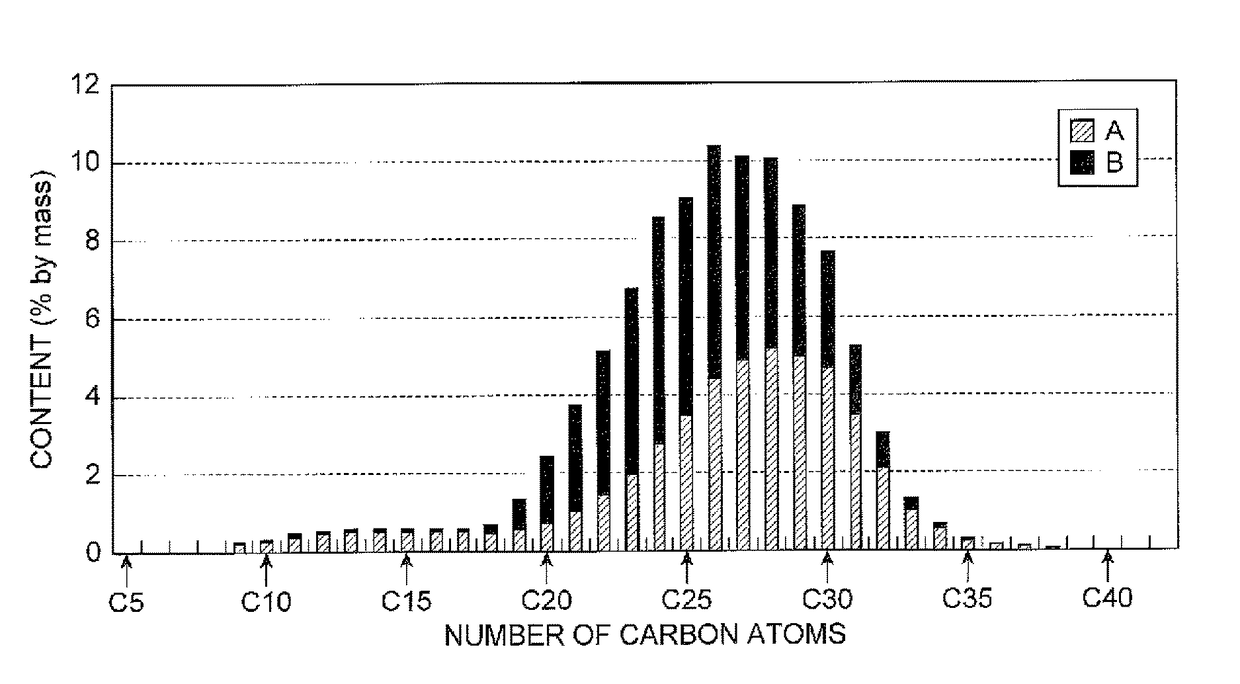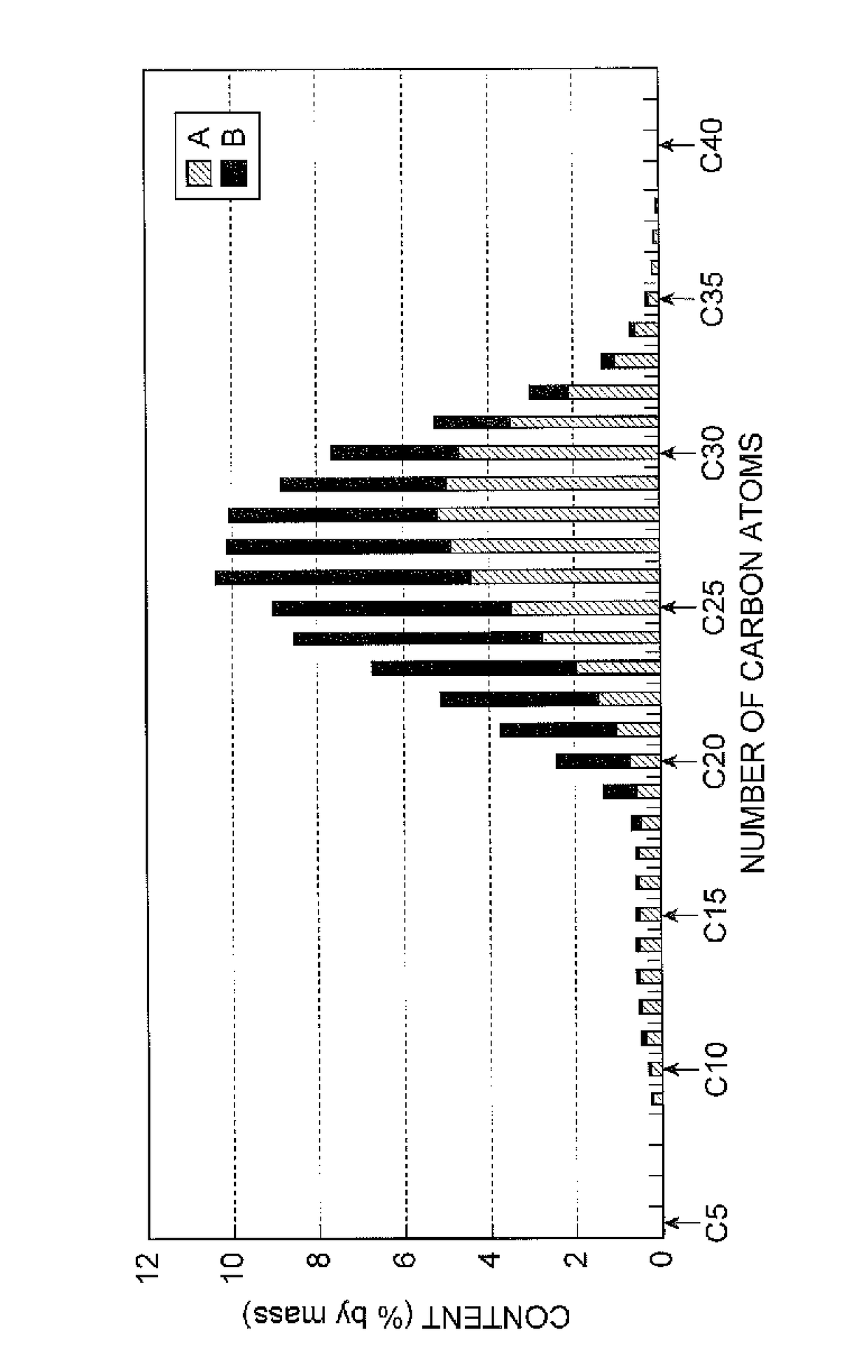Method for producing hydroisomerization catalyst and method for producing lubricant base oil
a technology of hydroisomerization catalyst and lubricant base oil, which is applied in the direction of physical/chemical process catalysts, organic chemistry, chemistry apparatus and processes, etc., can solve the problems of difficult economic production of a fraction to be prepared, difficult to efficiently produce desired fractions, and restricted product yields, etc., to achieve high isomerization selectivity
- Summary
- Abstract
- Description
- Claims
- Application Information
AI Technical Summary
Benefits of technology
Problems solved by technology
Method used
Image
Examples
production example 1
[0085]A ZSM-22 zeolite (hereinafter simply referred to as “ZSM-22”) including a crystalline aluminosilicate having the Si / Al ratio of 45 was produced by hydrothermal synthesis in the following manner.
[0086]At the start of the operation, the following four types of aqueous solutions were prepared.
[0087]Solution A: a solution prepared by dissolving 1.94 g of potassium hydroxide in 6.75 mL of deionized water.
[0088]Solution B: a solution prepared by dissolving 1.33 g of aluminum sulfate octadecahydrate in 5 mL of deionized water.
[0089]Solution C: a solution prepared by diluting 4.18 g of 1,6-hexanediamine (organic template) in 32.5 mL of deionized water.
[0090]Solution D: a solution prepared by diluting 18 g of colloidal silica (Ludox AS-40 manufactured by Grace Davison) in 31 mL of deionized water.
[0091]Then, the solution A was added to the solution B, and the mixture was agitated until aluminum components were completely dissolved. The solution C was added to the mixed solution, then t...
production example 2
[0101]A ZSM-48 zeolite with the Si / Al ratio of 45 containing organic templates (hereinafter may be simply referred to as “ZSM-48”) was synthesized on the basis of “Applied Catalysis A: General”, vol. 299(2006):167-174.
[0102]The following four types of reagents were prepared.
[0103]Reagent E: 2.97 g of sodium hydroxide
[0104]Reagent F: 0.80 g of aluminum sulfate octadecahydrate
[0105]Reagent G: 26.2 g of 1,6-hexanediamine (organic template)
[0106]Reagent H: 0.9 mL of 98% sulfuric acid solution
[0107]Reagent I: 75 g of aqueous solution (SiO2 concentration: 40%) of colloidal silica (Ludox AS-40 manufactured by Grace Davison)
[0108]The reagents E through I were then added to 180 mg deionized water and the mixture was agitated for 2 hours at room temperature until the reagents were completely dissolved therein.
[0109]The gelled substance prepared by the above-described operation was transferred into a stainless steel autoclave reactor having an internal volume of 100 mL, the autoclave reactor w...
production example 3
[0113]An SSZ-32 zeolite (hereinafter may also be simply referred to as an “SSZ-32”) was produced by hydrothermal synthesis in conformity with the method described in JP 2006-523136 A in the following manner.
[0114]Sodium hydroxides, aluminum sulfates, colloidal silica, isobutylamines, and N-methyl-N′-isopropyl-imidazolium cations were prepared by mixing at the following molar ratios:
[0115]SiO2 / Al2O3=35, and
[0116]the total content of the isobutylamine and the N-methyl-N′-isopropyl-imidazolium cation was 0.2 times as large as the content of SiO2.
[0117]The gelled substance prepared by the above-described operation was transferred into a stainless steel autoclave reactor having an internal volume of 100 mL, the autoclave reactor was rotated on a tumbling apparatus for 60 hours in an oven kept at 160° C. at the rotation speed of about 60 rpm to run a hydrothermal synthesis reaction. After the reaction was completely run, the reactor was cooled down, opened, and dried overnight in a drier ...
PUM
| Property | Measurement | Unit |
|---|---|---|
| temperature | aaaaa | aaaaa |
| boiling point | aaaaa | aaaaa |
| boiling point | aaaaa | aaaaa |
Abstract
Description
Claims
Application Information
 Login to View More
Login to View More - R&D
- Intellectual Property
- Life Sciences
- Materials
- Tech Scout
- Unparalleled Data Quality
- Higher Quality Content
- 60% Fewer Hallucinations
Browse by: Latest US Patents, China's latest patents, Technical Efficacy Thesaurus, Application Domain, Technology Topic, Popular Technical Reports.
© 2025 PatSnap. All rights reserved.Legal|Privacy policy|Modern Slavery Act Transparency Statement|Sitemap|About US| Contact US: help@patsnap.com


